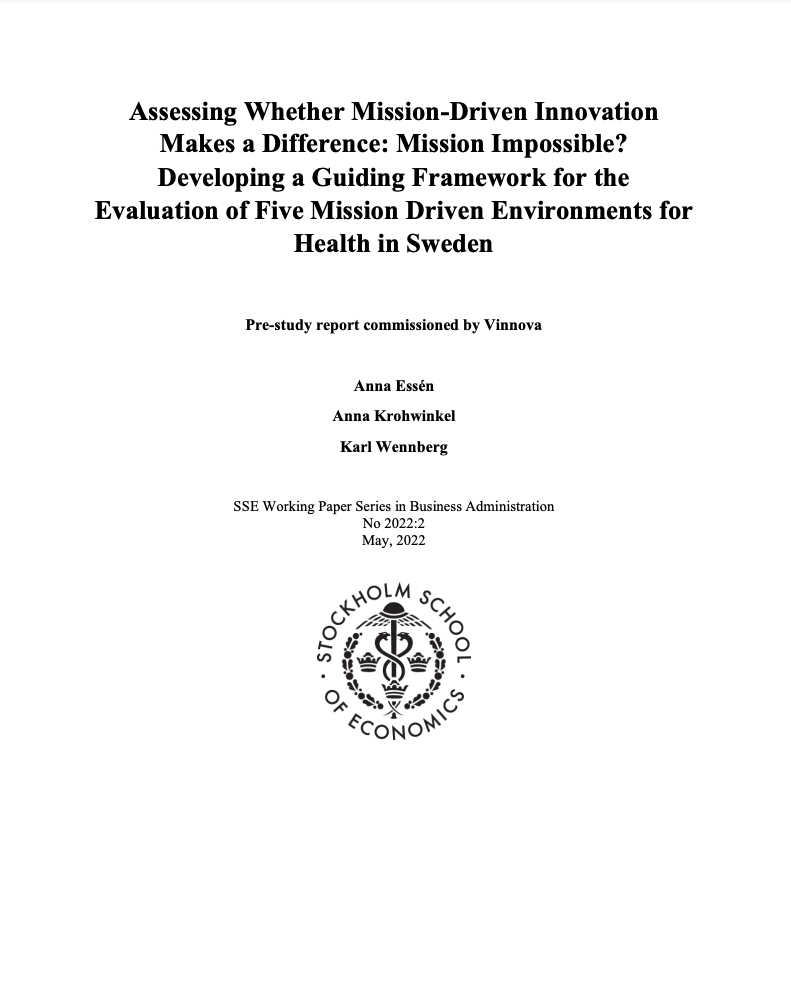Researchers at House of Innovation (SSE) are studying Vision Zero Cancer as an example of a meta-organization. This provides a unique opportunity to build theory about how such organizations drive and coordinate joint efforts, in the area of strategy and management research. Doctoral student John-Erik Bergkvist has together with senior researchers Anna Essén and Magnus Mähring followed Vision Zero Cancer from its inception.
Workshops about important topics in mission-driven innovation
The research team has as a part of the collaboration held workshops about topics that are critical for participants in mission-driven innovation.
Trust is a key governance mechanism in cross-sectorial innovation collaborations targeting complex societal problems (referred to as mission-driven innovation, innovation ecosystems etc.). Trust contributes to information sharing and is vital for motivation and the long-term loyalty, thus partly compensating for the often-low degree of formal and comprehensive contracts in such collaborations. In a workshop hosted by House of Innovation scholars John-Erik Bergkvist, Anna Essén, and Magnus Mähring, the role of trust in mission-driven innovation was explored. We discussed what trust is, the impact of trust and distrust in innovation collaboration, and explored key questions for Vision Zero Cancer to work with in order to build trust (and avoid overtrust). The slides are available here: : WS Trust_PDF
Motivation and interests in these types of collaborations are important to understand in order to maximize, and smooth coordination of, effort and to minimize misunderstandings among different participants’ behaviors. We discussed what motivates individuals, and the rationales for participating organizations and tried to understand each other better. The slides are available here: WS-Motivation_PDF.
Evaluating mission-driven innovation. Mission-driven innovation often targets complex and ambiguous problems, and aims to create long-term, systemic impact, well beyond the initiating organizations. Demonstrating ‘results’ is therefore challenging. In a workshop with vision zero cancer, researchers from House of Innovation (Anna Essén, John-Erik Bergkvist), GaPP (center for Governance and public policy) (Karl Wennberg) and leading health care (Anna Krohwinkel) discussed the who and what of evaluating mission-driven innovation. The workshop slides are available here: Evaluating MDI-Report_PDF and here: Slides Workshop-Evaluation Vision Zero_PDF and the template for bottleneck analysis is available here: Bottleneck analysis_DOC.
The workshop built on the report by and framework available here “Evaluating mission driven innovation”
Read more about our workshop on “Measuring Impact” here!
Ongoing research
How to govern mission-driven environments is a problem that remains underexplored in the strategy and management literature. In an ongoing study, John-Erik Bergkvist and colleagues draw on transaction cost economics to analyze how one can minimize costs (friction) in order to get a more efficient meta-organization. This is important because unnecessary friction might reduce the effort and make the same effort less impactful.
In another study, John-Erik and colleagues explore how interests are aligned in meta-organizations. How do Vision Zero Cancer and similar environments get people and organizations to work towards the same goal? Specifically, how can such environments get actors to make decisions and act on behalf of the meta-organization and its communal objectives? For more information, please contact John-Erik Bergkvist.
Other related work
House of Innovation researchers have published work on policy tied to health innovations and cross-sectorial innovation targeting public services. Please see our LinkedIn and Youtube. Please reach out to us if you have further questions.

To contact Anna please click here!
To contact John-Erik please click here!
Further reading
Although mission-driven innovation is underexplored, previous research in adjacent fields can provide insight into the potential challenges and ways to address them. Below, we list a selection of references that we find useful for people and groups interested in learning insights on inter-organizational collaborations from the strategy and management literature.
Gulati, R., Puranam, P., & Tushman, M. (2012). Meta‐organization design: Rethinking design in inter-organizational and community contexts. Strategic management journal, 33(6), 571-586
Gulati, R., Wohlgezogen, F., & Zhelyazkov, P. (2012). The two facets of collaboration: Cooperation and coordination in strategic alliances. Academy of Management Annals, 6(1), 531-583
Weber, L., & Mayer, K. (2014). Transaction cost economics and the cognitive perspective: Investigating the sources and governance of interpretive uncertainty. Academy of Management Review, 39(3), 344-36
Essén, A Krohwinkel, A Wennberg, K (2022). Assessing Whether Mission-Driven Innovation Makes a Difference: Mission Impossible? Developing a Guiding Framework for the Evaluation of Five Mission Driven Environments for Health in Sweden Pre-study report commissioned by Vinnova SSE Working Paper Series in Business Administration No 2022:2 May, 2022. Open access available here:

